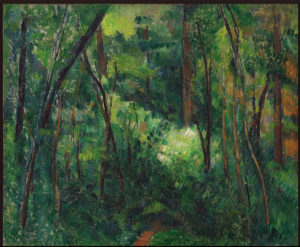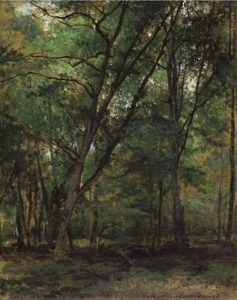R543 – Sous-bois, vers 1884 (FWN209)
Pavel Machotka
(Cliquer sur l’image pour l’agrandir)
It is one of the unequaled attainments of Cézanne’s mastery of the parallel touch that it could not only organize the canvas surface but represent objects and the spaces they occupy; in lesser hands, the dense yet independent touch in Sous-bois could amount to no more than a richly saturated tapestry. Here, thin saplings reach up toward the light and bend toward each other in an implied arch to frame and contain the many textures; and to create a layered space, foliage interrupts their trunks. A fragment of a path then enters the picture at the bottom, and a patch of light establishes a middle ground beyond which the wood becomes deep again. Having understood the space, we can begin to notice the different uses of the touch—the warp and weft of the brushstrokes between the saplings left of center, which suggest the leaves and the spaces between them, the parallel touches that make a bulky hedge that blocks our progression, and the general and indispensable denseness that an enclosed space requires. If it is a first lay-in—and the spaces between the touches suggest that much of it is—then Cézanne had a clear idea from the start how he wanted to proceed, and except for the buildup of paint in the center, which gave him the needed emphasis, achieved his purpose without further elaboration or correction. He achieved the color balance, too, at one go: within the constraints of a two-color scheme, he varied the color of the leaves from yellow through warm green, then cool green, and then blue-green, creating a broad spectrum to oppose the warm reds.
Adapted from Pavel Machotka, Cézanne: The Eye and the Mind.
On peut comparer avec César de Cock (1823-1904), élève de Daubigny et ami de Corot :



